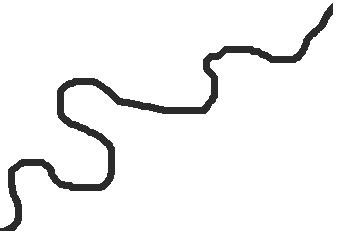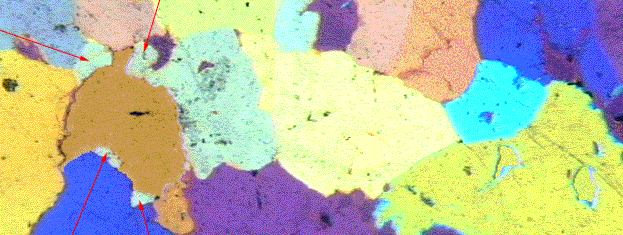Lab 2c- Evidence of recrystallisation in naturally
deformed rocks.
VIEPS/Mainz Microstructure Course
| TOC
| Lecture 1
2
3
4 a
b
5 a
b
| Lab 1 a
b
c
2 a
b
c
3 a
b
4 a
b
5 a
b
| Glossary Table
1
2
3
4
5
Index
|
Serrated Grain Boundary Formation.
Pictured below is a natural example of a serrated quartz grain boundary.
Serrated grain boundaries can form by the local migration of the boundary
in opposite directions. The same microstructure could also form by the
migration of the boundary in one direction only, but at different velocities.
-
What reasons can you think of as to why the grain
boundary might migrate at different speeds or directions along its length?

In this lab we shall re-examine the quartzite from the first lab in
terms of its place in a sequence of progressive deformation. ie the deformation
geometry and metamorphic conditions are stable, but the microstructure
evolves as different processes dominate.
7/1A or M1 [5 or 3] This is the same sample we
saw in the first lab. This time look at it in terms of the sequence that
follows.
-
What happens to the Grain Shape Foliation (GSF) &
Crystallographic Preferred Orientation (CPO) as we progress through this
sequence?

7/1B or M2 [5 or 6] Same rock, more strain. The
ratio of new recrystallised (small) grains to old grains has changed, and
many large grains are no longer in contact with each other, at least in
2D.
-
What reasons might there be for more strain to be
accommodated by the small newly recrystallised grains than the big old
grains?
-
What do these small grains do to your estimates of
strain? What are the average aspect ratios of the small grains versus the
large ones?

7/1C or M3 [3 or 4] Same rock, even more strain.
The average grain size in this sample is now much smaller than M1 or M2.
.
-
Notice that the specimen shows clusters of grains
with similar orientations, how might this domainal fabric develop?

7/1D or M4 [5 or 9] Same rock, more strain than
a grain can stand. Is the grain size now uniform in this rock, if not why
might it not be.
-
Are we still seeing the intra-crystalline microstructures
we saw at lower strains? What deformation mechanisms might have been active
in this rock?

73-1307 Cooma Quartzite [9] In this quartzite the
microstructure is markedly different from the previous suite of rocks,
and this is in part due to the higher temperature during deformation.
-
Document the differences between this specimen and
the previous ones, and explain the likely causes for the deformation microstructures
in this rock.
-
Notice the orientation family highlighted by the
4 red arrows, how did this microstructure form?







